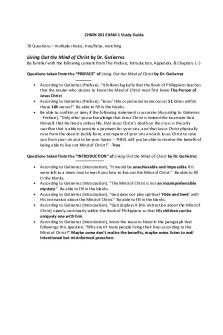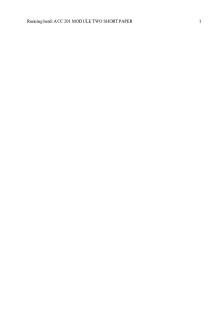Acc 201 exam 1 - Professor Dalton PDF

| Title | Acc 201 exam 1 - Professor Dalton |
|---|---|
| Course | Cost Accounting |
| Institution | University of San Diego |
| Pages | 4 |
| File Size | 97.9 KB |
| File Type | |
| Total Downloads | 43 |
| Total Views | 145 |
Summary
Professor Dalton...
Description
Chapter 1 https://quizlet.com/423848293/accounting-1-flash-cards/ Sole Proprietorship ● 1 owner controls ● Simple set-up ● No liabilities ● Tax advantages (individual pays taxes, not business) ● Income flows directly to individual Partnership (LLCs and LLPs) ● +2 partners; shared control ● Formed because of lack of economic resources ○ Tax advantages ● LLP: if in lawsuit, individuals are personally targeted in finance ● LLC: limited liability company protects individual owners’ personal finance ○ Partners file profit on individual tax returns; LLC does not file its own taxes ■ LLC > LLP; each owner splits profit on individual tax returns Corporations ● Organized as a separate legal entity owned by stockholders (publicly traded) ○ Investors receive shares of stock ● Easier to transfer ownership ● Easier for corps to raise funds as stockholders can invest with relatively small amounts of money ● Corps pay dividends to owners that are taxable → PROFITS TAXED TWICE (difference between sole proprietorship/partnership & C Corp S-Corporations ● Limited ownership ● Treated like LLC; owners are taxed rather than corporation → AVOIDS DOUBLE TAX ● Can’t be publicly traded Trusts
Governmental/non-governmental agencies that have a role in proposing GAAP/influencing GAAP ● Gov agencies approve of GAAP and prosecute those who don’t follow ● GAAP has an effect of LAW Basic concepts/principles of accounting ● Conservative principle of accounting: understanding the value of a company ○ If we have the choice between two equally valuable accounting methods, we generally choose the one that portrays it as less favorable → better to be conservative in our reports than to be optimistic
● Report REVENUE when it is EARNED (not when collected) ● Report EXPENSES when INCURRED (not when paid) Chapter 2 The four financial statements ● Income statement (just tells if a company is in profit or loss) ○ Revenues and expenses during a specific period of time, resulting in net income/loss ■ Revenues ● Service revenue ■ Expenses ● Salaries and wages, rent, depreciation, interest, insurance ■ Net Income (revenues - expenses = profit) ● Investors look at this because it predicts success in future ● Predicts future earnings ● Retained earnings statement ○ How much previous income was distributed to you and other owners (dividends), how much was retained to allow for future growth ○ Net income retained ○ Shows amounts and causes of changes in retained earnings for a specific time period ○ Retained earnings/add net income/less: dividend= ending retained earnings ○ Helps users determine company’s policy toward dividends and growth ● Balance sheet ○ What your business owns (assets) and what it owes (liabilities) at specific date ○ Owners claim to assets = stockholders’ equity ○ Claims of creditors = liabilities ○ Helps users determine if company relies on debt or stockholders’ equity to finance its assets ○ Assets= liabilities (DEBT) + stockholders’ equity ■ Assets listed in order of liquidity (how quickly they could be converted to cash) ● Ex: cash, accounts receivable, supplies, prepaid insurance, equipment ○ Order: ■ Assets ● Cash ● Accounts receivable ● Inventory ● Equipment ● Land (PPE) ● Security ● Prepaid expenses ■ Liabilities (notes payable, accounts payable, unearned service revenue, salaries payable, interest payable) ● Accounts payable ● Mortgage payable ● Taxes payable
●
●
●
● Salaries payable ● Unearned expenses ■ Stockholders’ equity ● Common stock ● Retained earnings Statement of cash flows ○ Where your business obtained cash during a period of time and how that cash was used ○ Provides information about cash receipts and cash payments of a business for a specific period of time ○ Helps determine if company generates enough cash from operations to fund its investing activities ■ Financing activities: getting in/out of debt (borrowing/repaying) anything with stock or dividend or shareholder related ■ Investing activities: buying/selling property or land ■ Operating activities: buying/selling inventory or profit on something being used, if equipment is helping you make something this is operating INTERRELATIONS ○ Retained earnings statement uses results of income statement ■ Net income is added to the beginning amount of retained earnings to determine ending retained earnings ■ Balance sheet and retained earnings ● Ending amount of retained earnings statement is reported as retained earnings on the balance sheet ■ Statement of cash flow and balance sheet ● Statement of cash flows shows how cash account changed during period; shows before, during, and after Decisions: ○ Are company’s operations profitable? → income statement ○ What is the company’s policy toward dividends and growth? → retained earnings statement ○ Does company rely primarily on debt or stockholders’ equity to finance its assets? → balance sheet ○ Does company generate sufficient cash from operations to fund its investing activities? → statement of cash flows
Current assets vs long term assets ● Current ○ Company expects to convert to cash or use up within one year ● Long term ○ Investments in stocks and bonds of other corporations that are held for more than a year ○ Land/buildings that a company is not using in its operating activities (property, plants and equipment)
○ Long term notes receivable ○ property Current liabilities vs long term liabilities ● Current liabilities ○ Obligations that the company is to pay within the year ■ Ex: accounts payable, notes payable, salaries payable, interest payable, interest taxes payable ● Long term liabilities ○ Obligations that a company expects to pay AFTER one year ■ Ex: bonds payable, mortgages payable, long term notes payable, lease liabilities, pension liabilities How to calculate: current ratio, debt to assets ratio, earnings per share ● Current ratio: total current assets/total current liabilities ● Debt to assets: total liabilities and equity-equity/total assets ● Earnings per share: Net profit/net sales ○ earnings available to common stockholders (net income-preferred dividends)/weighted-average common shares outstanding What does auditor report indicate - This is the opinion based section in a report that a CPA rights, someone outside of the company that gives an unbiased view on the company's growth for that year The MDAD - Is a report that is done from INSIDE the company, management's perspective of the years growth What are financial statement notes intended to do - Clarify anything that was left out, really just add any information that doesn’t fit in the sheets Chapter 3 How to record transactions in journal entries How to post journal entries in the accounts How to create a trial balance from the accounts ● Ensures that debits = credits How to create income statement, statement of changes in retained earnings, and balance sheet from trial balance ● Net income; increase/decrease in owner’s equity ○ REVENUE MINUS EXPENSES = NET INCOME ● Statement of changes in retained earnings; owner’s equity statement ○ Capital + net income = owner’s capital ● Balance sheet ○ Record assetts, record liabilities + equity
revenues/expenses are INCOME STATEMENT, everything else is BALANCE...
Similar Free PDFs

ACC 201 notes
- 4 Pages

ACC 201 Final exam Answer key1
- 11 Pages

CHMN 201 Exam 1 Guide
- 6 Pages

Accounting 201 Exam 1 Review
- 3 Pages

ACC 260 EXAM #1 Study Sheet
- 9 Pages
Popular Institutions
- Tinajero National High School - Annex
- Politeknik Caltex Riau
- Yokohama City University
- SGT University
- University of Al-Qadisiyah
- Divine Word College of Vigan
- Techniek College Rotterdam
- Universidade de Santiago
- Universiti Teknologi MARA Cawangan Johor Kampus Pasir Gudang
- Poltekkes Kemenkes Yogyakarta
- Baguio City National High School
- Colegio san marcos
- preparatoria uno
- Centro de Bachillerato Tecnológico Industrial y de Servicios No. 107
- Dalian Maritime University
- Quang Trung Secondary School
- Colegio Tecnológico en Informática
- Corporación Regional de Educación Superior
- Grupo CEDVA
- Dar Al Uloom University
- Centro de Estudios Preuniversitarios de la Universidad Nacional de Ingeniería
- 上智大学
- Aakash International School, Nuna Majara
- San Felipe Neri Catholic School
- Kang Chiao International School - New Taipei City
- Misamis Occidental National High School
- Institución Educativa Escuela Normal Juan Ladrilleros
- Kolehiyo ng Pantukan
- Batanes State College
- Instituto Continental
- Sekolah Menengah Kejuruan Kesehatan Kaltara (Tarakan)
- Colegio de La Inmaculada Concepcion - Cebu










